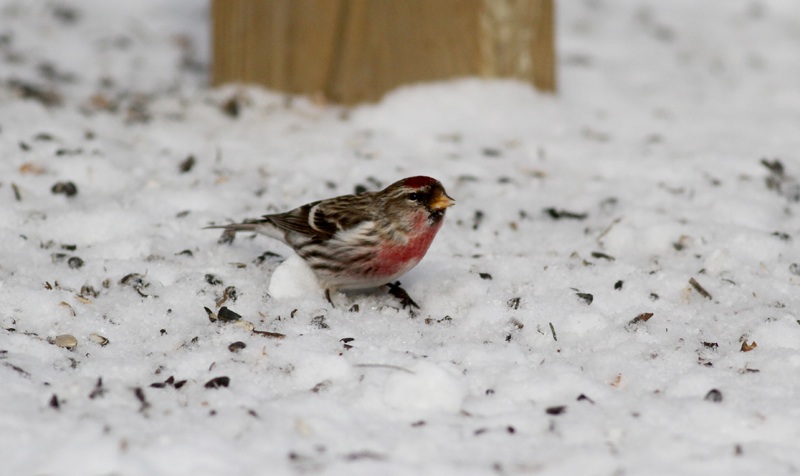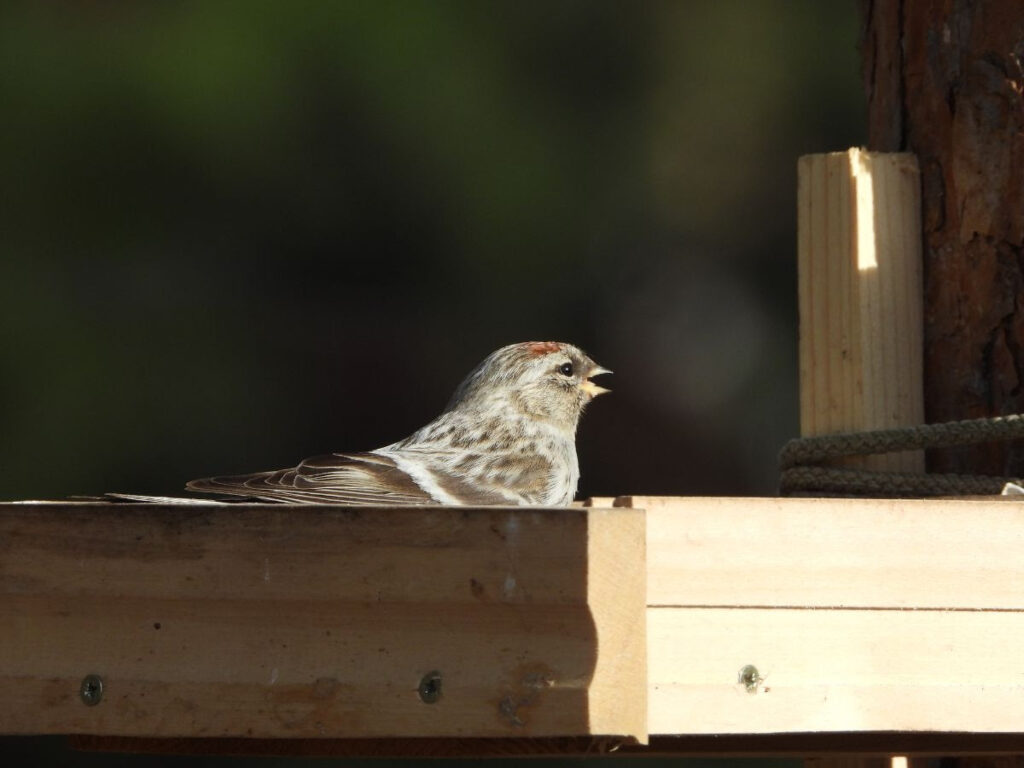How a New Feeder Visitor Unlocked a New Relationship with Nature
By Connor Rosenblatt
“No way…could it really be?”
That thought rushed through my head as I peered out the kitchen window on a sunny morning in December, 2012. I had been hearing for weeks about the spectacular finch irruption that was occurring in New England. All over eBird and Facebook birding pages, people were reporting impressive numbers of Pine Siskins, White-winged Crossbills, and Common Redpolls at their feeders. All of those species would be new birds for me. Alas, they had thus far evaded me that winter, and I was growing worried that the finch irruption was circumventing my small backyard.
But on this morning, as I sleepily rolled into the kitchen, I noticed a small bird on the thistle feeder across the yard. House Finches were frequent visitors, but this bird looked different at a quick glance. It was more compact and had a shorter, more pointed beak. There appeared to be a dark area right around the beak, too. I didn’t want to get too excited; I had been fooled many times already that season. Still, I reached across the counter to grab my binoculars, just in case.
Within seconds, just in case turned into I can’t believe it! Sitting on that feeder was a Common Redpoll; the first time I had ever seen one. With its bright red crown, rose-red chest, and smooth-white underside, this was truly the bird I had so badly wanted to see. As I watched it snack on the thistle seeds, a sudden movement caught my attention. In the shrub just next to this feeder was another Common Redpoll, who before long decided to join the feast. Shortly after, a third redpoll landed on the feeder. Then a fourth. Then a fifth. Before long, I had the privilege of watching five Common Redpolls together at the thistle feeder.

A redpoll at a feeder.
I felt giddy like a young child unwrapping birthday presents. My smile must have been a mile wide as I delighted in watching these birds dine peacefully together in the morning sunlight. On a frigid winter morning, watching these birds brought me all the warmth I needed. As the birds ate in peace, I too felt at peace. For that moment, the redpolls had my full attention. I felt relaxed. Time stood still, and all other thoughts in my mind disappeared. I wasn’t thinking about my calculus exam at school later in the day, or the fact that I needed to leave in 20 minutes but was still in my pajamas. All my thoughts were focused on those redpolls. How far up north did they come from? How in the world did they locate this lone feeder? How long would they stick around for? I was so honored that they felt like my backyard was a nice place to visit, even if only for the morning. Watching redpolls at my feeder that day was one of the most special moments I have ever had with birds. It wasn’t until nearly a decade later that I learned why that moment was so special: I felt connected to nature.
What exactly does it mean to feel connected to nature? It generally means that we see and feel the interrelatedness between our well-being and the well-being of nature. When we feel connected to nature, we see ourselves as a part of it, and nature as a part of us. As I watched the redpolls at my feeder, I was acutely aware of the emotional well-being I was experiencing. The presence of the redpolls provided me with relaxation, while I was simultaneously contributing to their own well-being by providing them with supplemental food to help them survive this irruptive journey. It was the perfect reciprocity of the moment that really made me feel a heightened sense of appreciation and awareness for the natural world.
Having this moment of nature connection provided me with enormous mental and emotional health benefits that morning, and it turns out that what I felt was just the surface of the positive impacts that feeling connected to nature can have. Researchers have identified other positive impacts on our health, such as reduced stress and anxiety, improved self-esteem, improved relationships with others, and better overall life satisfaction, for example.

What was it about the redpolls that allowed for me to have this moment of connection with nature? Why did the usual house finches at my feeders not produce the same results? Here is my theory: novelty invited me to slow down. That is, novelty in the form of biodiversity; seeing a rare bird at the feeder. Several researchers who have studied connection to nature have found a positive relationship with biodiversity (Biopholia): that is, the more species a person sees, the stronger their feelings of connection to nature. But what’s missing from these studies is the why. Why does seeing many different species make us feel more connected to nature than if we only see a single species? This is where I believe slowing down comes into play. Perhaps it is human nature, but when we see something unusual (like a new bird at the feeder) we become curious and excited. Rather than just glance and walk past it, we stop and study it. We note all the intricate patterns it has. We pay close attention to every behavior it does. We take time to experience the present moment. Indeed, research on connection to nature has found that one of the best ways to activate these feelings is through mindfulness: slowing down, looking deeply, and immersing our attention and awareness in what we are experiencing. And this is exactly what often happens to us when we see uncommon birds at our feeders.
Finches are a perfect group of birds to help us connect to nature. During irruption years, many finches that usually reside deep within the boreal forest move southward, often into city parks and backyards. These visitors are welcomed with excitement by birders, many of whom see these birds only when these irruptions occur. As such, we find that we might slow down and spend extra time marveling at these unique birds. And this can help us return to the present moment so that we are able to feel more connected to nature.
However, while uncommon feeder birds like winter finches invite us to slow down and connect to nature, they need not be the only birds. Having these moments of deep connection with nature is something that we can all have everyday with the common birds we already see. Even birds you have seen a thousand times before have the potential to help us experience a different kind of relationship with nature; one where we appreciate the interconnectedness that we have with the natural world. So, the next time you notice some birds at your feeder that you would ordinarily just take a quick glance at, try to pause for a bit longer. Be fully present with the experience and carefully notice the thoughts and emotions that arise within you. Because I think you might be surprised by what you experience.
At the end of the day, Wellness for Finches is Wellness for you!
Cover photo Ryan Brady
Connor Rosenblatt, is a PhD candidate in Ecology at the University of California, Davis. Connor’s dissertation research explores the mental health and wellness benefits of mindful birding. A key component of Connor’s research is understanding how adopting backyard bird feeding as a hobby deepens peoples’ connection to nature and improves their well-being.
FiRN is a nonprofit, and was granted 501c3 status in 2020. We are a co-lead on the Evening Grosbeak Road to Recovery Project, and have funded upwards of almost $8,000 to go towards research, conservation and education for finch projects in the last year plus. FiRN is committed to researching and protecting these birds and other threatened finch species like the Evening Grosbeak, Rosy-finches, and Hawaii’s finches the honeycreepers, and if you have been enjoying all the blogs and identifying of Evening Grosbeak and Red Crossbill call types (upwards of 20,000 recordings listened to), redpoll subspecies and green morph Pine Siskins FiRN has helped with over the years, please think about supporting our efforts and making a small donation at the donate link below.
Donate – FINCH RESEARCH NETWORK (finchnetwork.org)
Shirt Link
For a commemorative Winter Finch Forecast shirt where proceeds will go towards the study and conservation of finches and their habitats globally, see here: https://finchnetwork.org/shop
Feedercam
The Finch Research Network has a feedercam co-sponsored by Aspen Song Wild Bird Food, who is a member of Wild Bird Feeding Institute, and that went live again in Caribou, Maine this past November.
Please think about joining these Finch Research Network iNaturalist Projects:
Winter Finch Food Assessment Project/Become a Finch Forecaster: https://finchnetwork.org/the-finch-food-assessment-become-a-finch-forecaster
Red Crossbill North American Foraging Project: https://finchnetwork.org/crossbill-foraging-project
Evening Grosbeak North American Foraging Project: https://finchnetwork.org/evening-grosbeak-foraging-project

